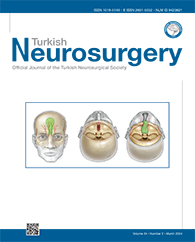2Clinical Medical College of Yangzhou University, Department of Neurosurgery, Jiangsu, China DOI : 10.5137/1019-5149.JTN.42396-22.2 AIM: To investigate the feasibility and safety of lumbar spinous process split laminotomy by quantitative anatomic analysis.
MATERIAL and METHODS: Nine fresh adult human cadaveric specimens (including 45 lumbar segments) were divided into 3 groups randomly. The simulated operations and anatomic measurements were performed to evaluate the visibility angle and surgical corridor at different retraction widths (8 mm, 10 mm, and 12 mm). By measuring the width causing bony fracture in 45 lumbar segments, the safety margin of retraction width was determined. The findings of lumbar spinous process split laminotomy in one typical case were presented.
RESULTS: At 8 mm retraction width, there was not enough surgical corridor for the operation procedures. At 10 mm and 12 mm retraction width, all operation procedures could be conducted smoothly. The 12 mm group presented a larger surgical corridor and shorter operative time compared with the 10 mm group. The imaging examination confirmed no bony fracture and articular capsule impairment. The visibility angle and exposure extent increased in proportion to the retraction width. The retraction width that resulted in the bony fracture ranged from 12.34 mm to 16.82 mm, with an average of (14.56 ± 1.73) mm. The positions of fracture were in the pedicle of the vertebral arch (68.9%), the lamina (26.7%), and the vertebral body (4.4%).
CONCLUSION: The retraction width of 10 mm-12 mm is safe and effective. The micromanipulations such as tumor resection, nervous exploration, dural suture, etc. can be conducted smoothly via the surgical corridor. In addition, the retraction width of 12.34~16.82 mm could serve as a safety margin for surgical planning. Our findings may provide a quantitative reference for clinical application of lumbar spinous process split laminotomy.
Keywords : Split laminotomy, Anatomic research, Simulated operation, Spinous Process




